Simulations of 2021 end-of-season corn yield potential and real-time crop stage were performed on Aug. 4 for 39 locations across the U.S. Corn Belt using the UNL Hybrid-Maize crop model in collaboration with faculty and extension educators from 10 universities. This article summarizes the simulated crop stages and yield forecasts; the data can be viewed in Table 1. Details on the UNL Hybrid-Maize crop model and the underpinning methodology to simulate phenology and forecast end-of-season yields, as well as on interpretation and uses of yield forecasts, are described in a previous article. Note that one location in IL (Olney) was not included for the forecasts due to lack of weather data.
Although past weeks have alternate high and low temperatures, on average, air temperature over the past three weeks has remained near the historical average in most of the Corn Belt, with a few sites showing values below (KS) or above (ND and northern MN) the historical average. In the case of rainfall, most locations in the eastern fringe of the Corn Belt exhibited near-normal rainfall, while most sites in NE, MN and ND and some sites in IA and KS presented below normal rainfall. A summary of weather conditions during the last three weeks is shown in Figure 1.

| Location | Water regime | Long-term average yield (bu/ac) § | Range of Yp forecasts as of Aug 03 (bu/ac)¶ 25th | Range of Yp forecasts as of Aug 03 (bu/ac)¶ 75th | Probability (%) of 2021 yield to be: Below (relative to the long-term Yp)† | Probability (%) of 2021 yield to be: Near (relative to the long-term Yp)† | Probability (%) of 2021 yield to be: Above (relative to the long-term Yp)† | Simulated current crop stage* | |
|---|---|---|---|---|---|---|---|---|---|
| NE | Alliance | Irrigated | 193 | 190 | 215 | 0% | 69% | 31% | R3, Milk |
| Beatrice | Dryland | 162 | 140 | 175 | 39% | 45% | 16% | R4, Dough | |
| Irrigated | 230 | 217 | 233 | 16% | 84% | 0% | R4, Dough | ||
| Clay Center | Dryland | 160 | 47 | 110 | 95% | 5% | 0% | R3, Milk | |
| Irrigated | 245 | 229 | 253 | 13% | 82% | 5% | R3, Milk | ||
| Concord | Dryland | 177 | 89 | 117 | 100% | 0% | 0% | R2, Blister | |
| Irrigated | 249 | 233 | 269 | 8% | 77% | 15% | R3, Milk | ||
| Elgin | Irrigated | 252 | 239 | 271 | 6% | 70% | 24% | R2, Blister | |
| Holdrege | Dryland | 115 | 75 | 135 | 42% | 21% | 36% | R3, Milk | |
| Irrigated | 242 | 225 | 264 | 15% | 64% | 21% | R2, Blister | ||
| McCook | Dryland | 88 | 59 | 92 | 51% | 31% | 18% | R4, Dough | |
| Irrigated | 225 | 201 | 225 | 31% | 67% | 3% | R4, Dough | ||
| Mead | Dryland | 183 | 109 | 164 | 74% | 21% | 5% | R3, Milk | |
| Irrigated | 235 | 218 | 239 | 18% | 74% | 8% | R3, Milk | ||
| North Platte | Dryland | 91 | 48 | 95 | 64% | 18% | 18% | R3, Milk | |
| Irrigated | 234 | 229 | 264 | 3% | 59% | 38% | R3, Milk | ||
| O'Neill | Irrigated | 227 | 207 | 234 | 22% | 67% | 11% | R3, Milk | |
| IA | Ames | Dryland | 231 | 172 | 188 | 94% | 6% | 0% | R4, Dough |
| Crawfordsville | Dryland | 230 | 215 | 235 | 13% | 81% | 6% | R3, Milk | |
| Lewis | Dryland | 209 | 208 | 239 | 9% | 52% | 39% | R3, Milk | |
| Nashua | Dryland | 229 | 181 | 198 | 91% | 6% | 3% | R3, Milk | |
| Sutherland | Dryland | 211 | 192 | 208 | 25% | 66% | 9% | R3, Milk | |
| IL | Bondville | Dryland | 235 | 236 | 268 | 0% | 59% | 41% | R3, Milk |
| Freeport | Dryland | 213 | 175 | 203 | 45% | 42% | 13% | R3, Milk | |
| Olney | Dryland | 189 | |||||||
| Peoria | Dryland | 210 | 219 | 244 | 0% | 64% | 36% | R3, Milk | |
| Springfield | Dryland | 178 | 217 | 229 | 0% | 5% | 95% | R4, Dough | |
| IN | Butlerville | Dryland | 225 | 207 | 233 | 22% | 78% | 0% | R3, Milk |
| Columbia City | Dryland | 224 | 222 | 238 | 0% | 83% | 17% | R2, Blister | |
| Davis | Dryland | 231 | 233 | 255 | 0% | 72% | 28% | R2, Blister | |
| West Lafayette | Dryland | 238 | 230 | 256 | 0% | 83% | 17% | R3, Milk | |
| KS | Garden City | Irrigated | 219 | 199 | 221 | 20% | 77% | 3% | R4, Dough |
| Hutchinson | Dryland | 100 | 102 | 113 | 0% | 68% | 32% | R5, Dent | |
| Manhattan | Dryland | 135 | 159 | 174 | 0% | 6% | 94% | R4, Dough | |
| Scandia | Dryland | 132 | 41 | 78 | 100% | 0% | 0% | R3, Milk | |
| Irrigated | 225 | 215 | 249 | 9% | 66% | 26% | R3, Milk | ||
| Silverlake | Dryland | 140 | 153 | 166 | 0% | 34% | 66% | R4, Dough | |
| Irrigated | 210 | 192 | 212 | 17% | 83% | 0% | R4, Dough | ||
| MI | Ceresco | Dryland | 177 | 212 | 249 | 0% | 10% | 90% | R2, Blister |
| MN | Eldred | Dryland | 115 | 8 | 9 | 100% | 0% | 0% | R3, Milk |
| Lamberton | Dryland | 215 | 155 | 170 | 100% | 0% | 0% | R3, Milk | |
| Waseca | Dryland | 219 | 190 | 232 | 32% | 54% | 15% | R3, Milk | |
| MO | Brunswick | Dryland | 181 | 182 | 201 | 0% | 71% | 29% | R3, Milk |
| Monroe City | Dryland | 172 | 204 | 226 | 0% | 5% | 95% | R3, Milk | |
| St Joseph | Dryland | 165 | 184 | 207 | 5% | 14% | 81% | R3, Milk | |
| ND | Dazey | Dryland | 113 | 0 | 0 | 100% | 0% | 0% | R3, Milk |
| OH | Custar | Dryland | 208 | 198 | 222 | 11% | 72% | 17% | R2, Blister |
| South Charleston | Dryland | 216 | 205 | 234 | 6% | 77% | 16% | R2, Blister | |
| Wooster | Dryland | 210 | 209 | 229 | 6% | 72% | 22% | R2, Blister |
§Long-term (last 20+ years) potential yield at each location and surrounding area.
¶ Range of forecasted 2021 potential yields based on average planting date in 2021, indicating the potential yields in the 25th and 75th percentile of the potential yield distribution (associated with respective adverse and favorable weather scenarios during the rest of the season).
† Probability of obtaining a 2021 yield below (10%) than the long-term potential yield at each location.
Simulated Corn Stage Across 40 Locations
Corn has reached kernel milk stage in almost the entire Corn Belt, except for the eastern fringe of the region (OH, MI and IN) where it is still in blister stage. Some sites in the southern fringe of the region (KS and southern NE and IL) are ahead of the rest of the locations, with corn reaching the dough and even dent stage (Figure 2). Most locations are similar to last year’s corn development by Aug. 4.
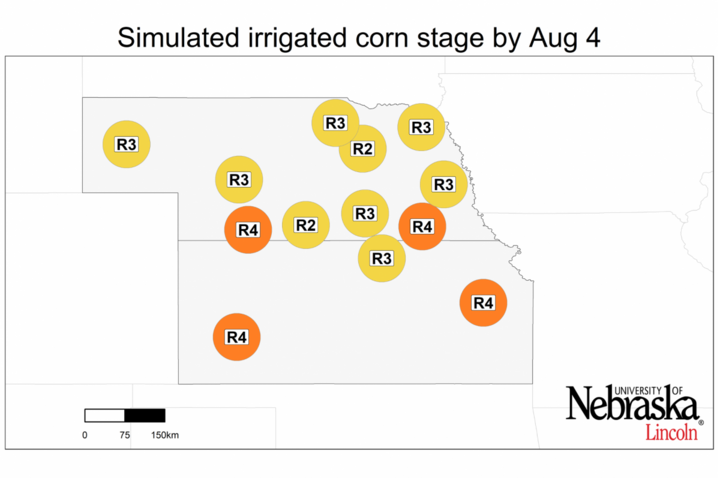
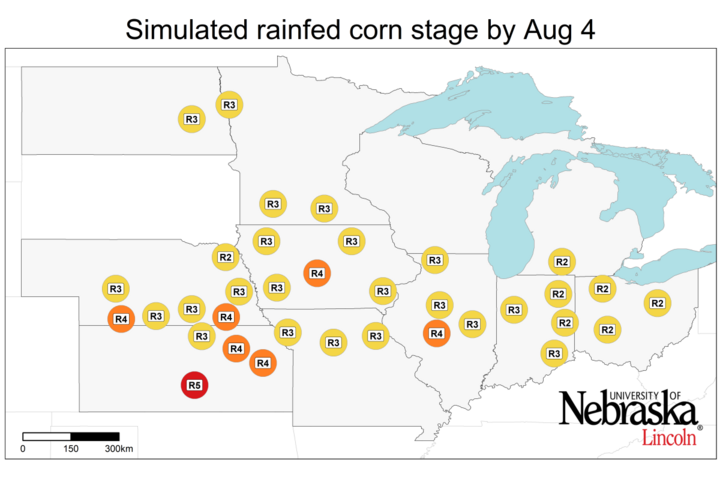
Irrigated Corn: High Probability of Near-average Yields
The range of forecasted irrigated corn yield potential for each location, as well as the probabilities for yields above, near or below average, are shown in Figures 3 and 4. Six out of 13 sites exhibit a high probability (>75%, that is, a chance of three out of four) of near-average yield potential. Favorable weather during the rest of the season that results in a long grain-filling period may increase the likelihood of above-average yield. The chance of below-average yield is low across all irrigated sites. At this point, the forecasted scenario for irrigated maize in the current season seems similar to the 2020 forecasts in nine out of 13 sites.
Variable 2021 Forecasted Corn Yield Across Rainfed Locations
Forecasted yield potential is highly variable across the 35 rainfed sites (Figures 3 and 4). There is a high probability of above-average yield (>75%) at five sites in the southern fringe of the Corn Belt and MI, while nine sites distributed across the central (IA), western (NE and northern KS), and northern (ND and MN) regions have a high probability of below-average yields. Very low yields are predicted at the uttermost northern sites (Eldred, MN and Dazey, ND). Probability of near-average yield is relatively high in the central and eastern part of the Corn Belt (most of IL, IN and OH).
Compared with our previous forecast, below-average rainfall in most of NE, ND, MN and two sites in IA during the past three weeks increased the probability of below-average yields in that area, reducing the forecasted yield for the 2021 season. In contrast, above-average rainfall in a few scattered locations (Manhattan, KS, Ceresco, MI and South Charleston, OH) has improved the yield forecasted for rainfed maize in those sites by mid-July. Compared with the 2020 forecast, the forecasted scenario for rainfed maize seems more pessimistic in ND, MN, northwestern NE and central IA in the current season. In the remaining area, the scenario looks similar or even more favorable compared with 2020 forecasts.
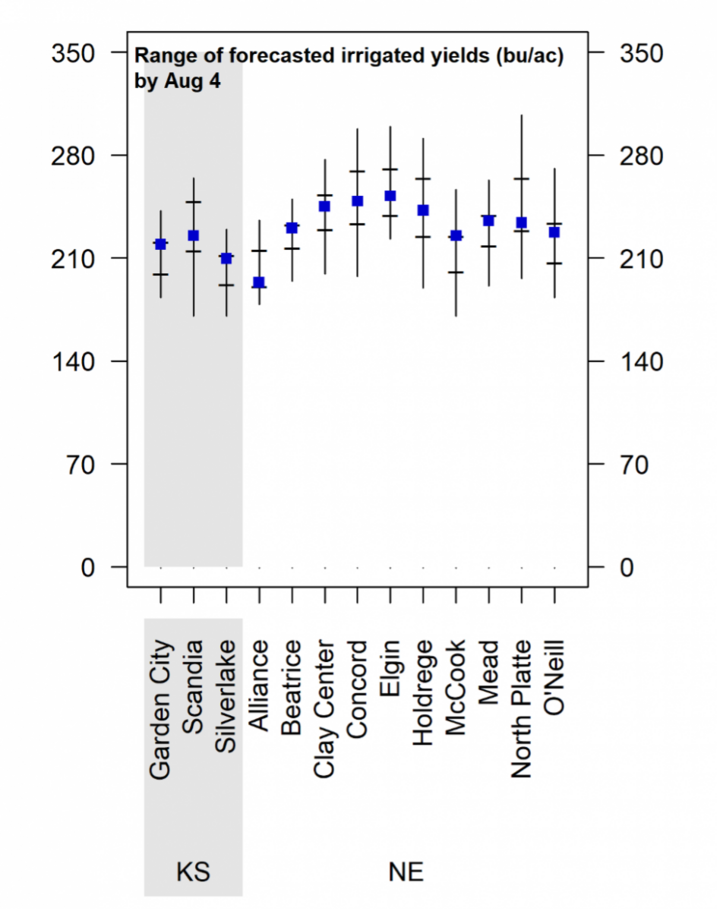
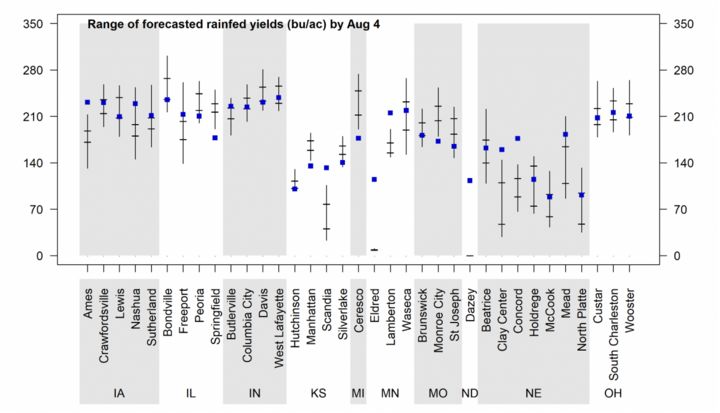
Yields in Dazey, ND and Eldred, MN cannot be accurately forecasted due to very low rainfall.
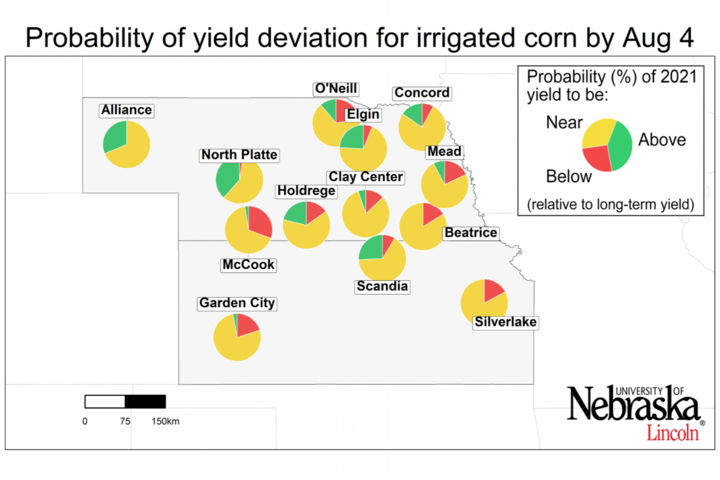

Conclusions
Similarly to our previous forecast in mid-July, the probability for a “record yield year” for the whole country is low considering that the probability for above average yield is small (
For rainfed corn, the scenario is diverse across regions. Most sites in the central and eastern part of the Corn Belt have a high probability of near-average yields. Above-average yield is expected at five locations mostly located in the southern fringe of the Corn Belt and MI. In contrast, nine sites located in the western and northern areas of the Corn Belt and central IA exhibit a high probability of below-average yields. Temperature and rainfall during August will likely define the trend for all sites across the region.
These forecasts do not take into consideration problems with stand emergence, hail/flooding damage, replanting situations, disease or nitrate leaching. In fields negatively affected by these constraints, actual yields will be lower than estimates provided here. It is important to keep in mind that yield forecasts are not field specific and, instead, represent an estimate of average on-farm yield for a given location and surrounding area in absence of the yield-reducing factors mentioned here. Likewise, crop stages and forecasted yields will deviate from the ones reported here in fields with planting dates or hybrid maturities that differ markedly from those used as the basis for the forecasts (see Table 1 in this July 14 article). We will follow up with further forecasts in late August.
